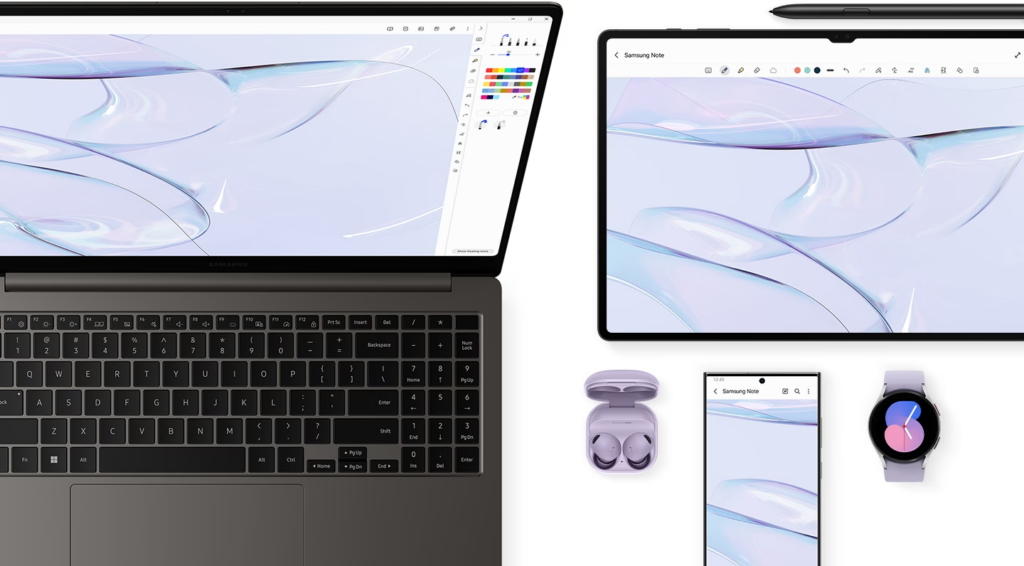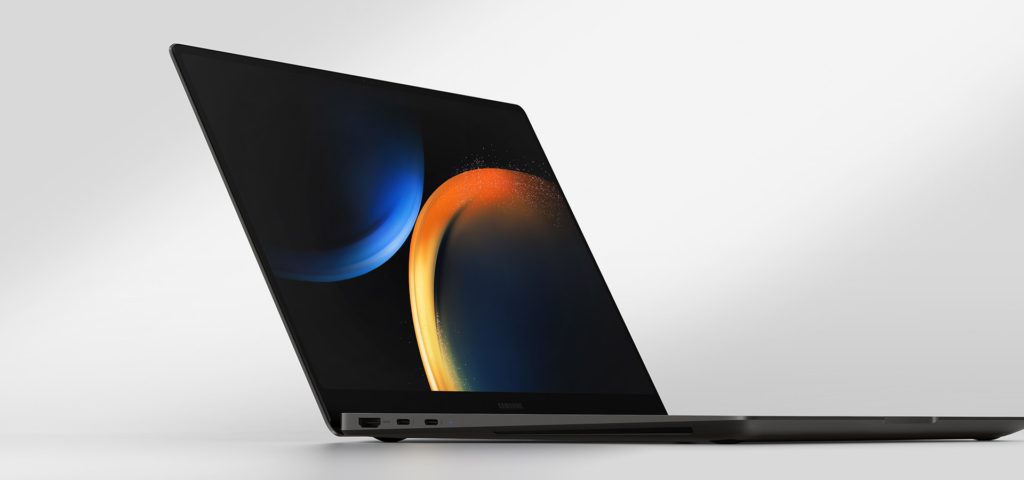Samsung Galaxy Book3 Ultra, a slender and lightweight 16-inch Windows laptop housing a dedicated GPU, serves as a key takeaway.
With an Intel Core i7 and Nvidia RTX 4050 GPU, this Galaxy Book targets on-the-go users handling graphics-intensive tasks. However, it’s important to note that these components may not match the raw graphics prowess of a 16-inch MacBook Pro or various Windows gaming laptops, especially in terms of battery life.
Yet, the Galaxy Book3 Ultra distinguishes itself by offering two unique features absent in its competitors: seamless integration with the Galaxy ecosystem, albeit limited, and a chassis weighing under four pounds.

Samsung’s Galaxy Book Pro series has traditionally focused on blending slim form factors, exceptional displays, and Galaxy phone compatibility. However, by equipping the Ultra with an RTX GPU and pricing it at $2,399.99, Samsung ventures into the professional market after several years. This endeavor, while commendable, places the Ultra in a fiercely competitive niche.
Samsung Galaxy Book3 Ultra:
NewForTech Opinion:
Cons:
- Remarkably slim and lightweight for workstation-class laptops
- OLED display featuring adaptive refresh rate
- Seamless connectivity options for Galaxy smartphone users
Cons:
- Relatively high price point
- RTX 4050 GPU falls short of top-tier performance
- Webcam performance is mediocre
For someone like me, who isn’t a Galaxy phone user, the Ultra’s standout feature is its slim, lightweight design. At just 0.65 inches thick and 3.95 pounds, it’s among the most portable laptops with an RTX GPU. In fact, it’s lighter than the Dell XPS 15 and almost a full pound lighter than the 16-inch MacBook Pro.

Samsung Galaxy Book3 Ultra specs:
| Specification | Details |
|---|---|
| Display | 16-inch 3K OLED (2880 x 1800) |
| Dimensions | 13.99 x 9.86 x 0.65 inches (355.35 x 250.44 x 16.51mm) |
| Weight | 3.95 lbs (1.79 kg) |
| Processor | Intel Core i7-13700H |
| GPU | Nvidia GeForce RTX 4050 |
| RAM | 16 GB |
| SSD | 1 TB |
| Wireless | Wi-Fi 6E (Gig+), 802.11abgn/ac/ax, Bluetooth v5.1 |
| Ports | HDMI 2.0, Thunderbolt 4 (x2), USB-A 3.2, microSD, headphone out/mic in combo |
| Price | $2,399.99 |
However, I want to emphasize that this doesn’t mean it’s featherlight. Being a 16-inch laptop, it still occupies space in my backpack, and four pounds isn’t negligible. If you need a versatile laptop for occasional graphics work, there are lighter options available, like the 3.3-pound MacBook Air 15. But if you’re committed to the premium workstation category and demand the utmost portability, the Galaxy Book3 Ultra might be your top choice.

The Ultra boasts other impressive but less unique features. The display, in typical Samsung fashion, is exquisite. It’s a 120Hz OLED panel with an adaptive refresh rate and a resolution of 2880 x 1800. The scrolling is noticeably smooth, and the colors and contrast are stunning. It covers 100% of the sRGB gamut, 98% of AdobeRGB, and 100% of P3, with a peak brightness of 434 nits. However, it’s worth noting that glare can be an issue, especially below 60% brightness.
Additionally, the Galaxy ecosystem integration is worth mentioning. Samsung aims to replicate the seamless experience that Apple offers with its MacBooks and iPhones. Features like AirDrop and Universal Control are available, along with various interoperability features across Samsung laptops. The Ultra supports Samsung Multi Control, allowing you to operate the S23 with the Galaxy Book’s keyboard and trackpad. While its relevance to professional creators might be limited, it functions well.
For users who shoot on an S23 and edit on a computer, features like Quick Share (similar to AirDrop) and Expert RAW file transfer can be handy. They simplify the process of transferring photos, videos, and RAW files between Galaxy phones and Galaxy Books. Many of these features are also accessible on other Galaxy Book models.
A Close Look at Features and Performance
To start, Samsung offers Studio Mode, an improved feature for video calls that enhances your appearance automatically. Auto Framing smoothly tracked my movements, but the background blur had limitations. Face effects subtly adjust lighting, though sometimes making me appear pallid.
Despite these effects, the FHD webcam itself disappointed me, often making me look washed out and fuzzy. Fortunately, the Ultra boasts a rich array of ports, including USB-A, HDMI, microSD, and a headphone jack, along with two Thunderbolt 4 ports for connecting an external webcam.
One peculiar aspect was the oversized touchpad, which occasionally registered unintended clicks when I rested my palm. This occasional annoyance felt out of place on a $2,300 device.
Samsung offers two Galaxy Book3 Ultra models, with my unit (Core i7, RTX 4050, 16GB RAM, 1TB storage) being the cheaper one. The pricier SKU, equipped with a Core i9 and RTX 4070, costs $2,999.99. To put the added GPU cost into perspective, the standard Galaxy Book3 Pro with a Core i7 retails at $1,749.99. While it has a smaller screen, it’s nearly half a pound lighter and excels in portability.

The RTX 4050 elevates performance significantly, though it’s not a top-tier GPU. The Ultra breezed through standard tasks without hiccups, offering speed comparable to productivity laptops. It remained quiet, and heat wasn’t an issue.
In terms of CPU performance under load, the Ultra slightly outperforms the 16-inch MacBook Pro in single-core benchmarks but lags in multicore tests. It’s important to note that the RTX 4050, with only 6GB of VRAM, isn’t a high-end graphics card and doesn’t approach the performance of Apple’s M2 Max.

However, the Ultra pleasantly surprised me with its battery life, averaging eight hours and eight minutes per charge, even with the dynamic refresh rate enabled. While not matching MacBook battery life, it’s commendable compared to Intel-based laptops with large, bright displays.
In summary, the Galaxy Book Ultra offers a unique experience with solid advantages for Samsung enthusiasts. My main concerns, the touchpad and webcam, can be resolved through peripherals, thanks to the diverse port selection.
Nevertheless, the $2,399 price may seem steep for most users. If you prioritize mobile photo and video work, it’s worth considering. However, for Windows enthusiasts, the Dell XPS 15 offers a better GPU and higher-resolution screen at a similar price point.
While the Galaxy Book is more portable than the 16-inch MacBook Pro, it falls short in multicore performance, battery life, keyboard, touchpad, and build quality. For these attributes in the Windows realm, you’d need to explore options like HP’s Spectre x360, although it currently lacks Nvidia GPUs.
We’re still waiting for the Windows ecosystem to deliver a thin, light machine with a premium chassis, all-day battery life, and competitive graphics power. The Galaxy Book3 Ultra comes close but doesn’t quite reach that level.

Leave a Reply